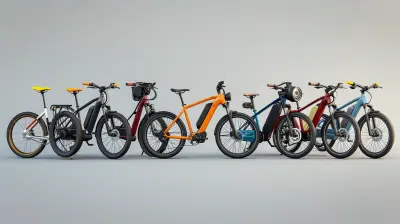Exploring the Role of Thermal Management in Battery Systems
22 June 2025
Batteries are the backbone of modern technology, powering everything from smartphones to electric vehicles (EVs). But as we demand more power and efficiency, one challenge becomes increasingly critical—thermal management. Managing battery temperature isn't just about avoiding overheating; it’s about maximizing performance, longevity, and safety.
So, what exactly is thermal management in battery systems, and why does it matter? Let’s break it down in a simple yet detailed way. 
Why Is Thermal Management Important in Battery Systems?
Think of a battery as a human body. Just as we function best within a certain temperature range, so do batteries. If a person gets too cold, they shiver; if they get too hot, they overheat—both conditions affecting performance. Similarly, batteries operate efficiently within a specific temperature range, typically between 15°C and 35°C (59°F - 95°F).If a battery gets too hot, its performance suffers, and its lifespan shortens. Worse, extreme heat can lead to thermal runaway, where a battery overheats uncontrollably, potentially causing fires or explosions. On the flip side, if a battery gets too cold, its efficiency drops, leading to reduced capacity and sluggish performance.
This is where thermal management systems come in—they help regulate temperature to maintain optimal performance, safety, and battery longevity. 
How Heat Affects Battery Performance and Lifespan
🔥 Overheating Hazards
When a battery generates excessive heat, several negative effects follow:- Accelerated Degradation – Heat speeds up chemical reactions inside the battery, causing faster wear and tear.
- Reduced Efficiency – High temperatures can lead to increased internal resistance, which reduces overall battery efficiency.
- Thermal Runaway – In extreme cases, excessive heat can trigger thermal runaway, where one overheating cell causes a chain reaction of failures, leading to catastrophic battery failure.
❄️ Cold Temperature Challenges
While overheating is a well-known issue, cold temperatures can be just as problematic:- Reduced Charge Acceptance – Batteries charge slower in colder conditions, making EV charging slower in winter.
- Lower Capacity – Low temperatures reduce the movement of lithium ions, decreasing battery output.
- Potential Damage – If a battery freezes, it may suffer permanent damage, reducing its lifespan.
Because of these risks, thermal management is crucial for ensuring batteries perform optimally in both hot and cold conditions. 
Types of Thermal Management Systems
Thankfully, engineers have developed several ways to regulate battery temperature. Let’s explore the most common thermal management techniques used in different battery systems.1. Air Cooling
🚗 Used in: Some Electric Vehicles (EVs), Consumer ElectronicsAir cooling is the simplest method. It involves using fans or natural airflow to dissipate heat. Some EVs, like early Nissan Leaf models, used passive or active air cooling. While it’s inexpensive and easy to implement, it’s less effective for high-performance applications, where more advanced cooling methods are required.
2. Liquid Cooling
🚘 Used in: High-Performance EVs, Industrial ApplicationsLiquid cooling systems use water-glycol mixtures or specialized coolants to absorb and transfer heat away from battery cells. This system is used in Tesla, BMW, and other high-end EVs because it provides better heat dissipation and temperature consistency compared to air cooling. Although it’s costlier and more complex, it significantly improves battery performance and longevity.
3. Phase Change Materials (PCM)
🛠 Used in: Aerospace, High-End Battery PacksPhase Change Materials absorb heat by changing their state (from solid to liquid) when the battery gets hot. They store thermal energy efficiently, stabilizing temperature fluctuations. While PCM is effective, it’s not widely adopted due to cost and limited scalability.
4. Thermoelectric Cooling
⚡ Used in: Specialized Applications (Military, Medical Devices)Thermoelectric cooling employs the Peltier effect, where electrical current creates a temperature difference between two materials. Though these systems are compact and reliable, they consume more energy, making them impractical for large-scale systems like EVs.
5. Refrigerant-Based Cooling
🆒 Used in: High-Performance EVs and Energy Storage SystemsSome advanced EVs use direct refrigerant cooling, where a refrigeration cycle actively cools down the battery pack. This method provides superior temperature control but comes at a higher cost.
Each of these systems has its own pros and cons, and manufacturers choose them based on application, efficiency, and cost. 
Innovations in Battery Thermal Management
The future of battery thermal management looks promising, with new materials and AI-driven cooling solutions leading the way.1. Solid-State Batteries
Solid-state batteries, unlike traditional lithium-ion batteries, generate less heat and are inherently safer. Since they don’t use liquid electrolytes, the risk of thermal runaway is significantly reduced. Many researchers believe solid-state batteries could revolutionize the EV industry.2. AI and Smart Cooling Systems
Artificial intelligence is transforming battery temperature regulation. AI-driven cooling systems analyze data in real-time, adjusting cooling mechanisms dynamically to optimize battery life and energy efficiency.3. Advanced Thermal Interface Materials (TIMs)
New materials like graphene-based heat spreaders and nano-engineered phase change materials are improving heat dissipation in battery packs, making them more efficient.The combination of these innovations could drastically improve energy storage systems, leading to longer-lasting, safer, and more efficient batteries.
Thermal Management in Electric Vehicles (EVs)
EVs rely on lithium-ion batteries, which generate heat during charging and discharging. Effective thermal management systems are essential to avoid overheating, improve range, and extend battery lifespan.📌 Challenges EVs Face Without Proper Thermal Management
1. Faster Battery Degradation – Poor cooling leads to rapid capacity loss.2. Reduced Driving Range – Overheated batteries lose efficiency, lowering the vehicle’s range.
3. Longer Charging Times – Temperature fluctuations can reduce fast-charging efficiency.
4. Safety Risks – In extreme cases, overheating can lead to fires or explosions.
To overcome these challenges, companies like Tesla, Rivian, and Lucid Motors use advanced liquid cooling and AI-driven temperature control systems.
Best Practices for Battery Thermal Management
Whether it's an EV battery or a smartphone, following these best practices can enhance battery life:✅ Avoid Extreme Temperatures – Don’t expose batteries to excessive heat or freezing conditions.
✅ Use Efficient Charging Practices – Fast-charging in extremely hot or cold conditions can degrade the battery.
✅ Implement Proper Cooling Techniques – Whether air-cooling, liquid-cooling, or AI-based systems, investing in temperature management pays off in the long run.
✅ Utilize Smart Battery Management Systems (BMS) – Advanced BMS optimize charging cycles and prevent overheating.
Final Thoughts
Thermal management in battery systems is not just a luxury—it’s a necessity. Whether you’re driving an EV, using a smartphone, or working with energy storage solutions, temperature control plays a vital role in performance, efficiency, and safety.With the rise of solid-state batteries, AI-driven cooling, and innovative new materials, the future of battery technology looks brighter, safer, and more efficient than ever.
As we move toward a future dominated by electric mobility and renewable energy, one thing is clear—thermal management will remain a critical factor in maximizing battery potential.
all images in this post were generated using AI tools
Category:
Battery TechnologyAuthor:

Vincent Hubbard
Discussion
rate this article
1 comments
Solstice Jennings
How does thermal management impact battery life and efficiency overall?
June 29, 2025 at 11:09 AM

Vincent Hubbard
Thermal management is crucial as it regulates battery temperature, preventing overheating and degradation, which in turn enhances battery life and overall efficiency.


